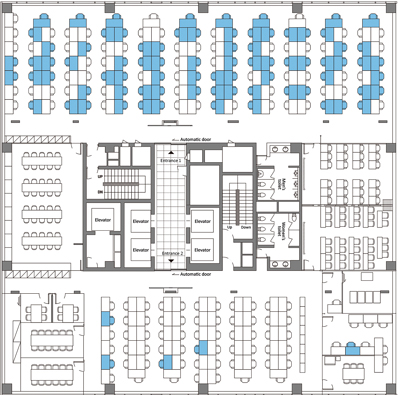Healthier Buildings: Guidelines for Commercial Ventilation and Employee Health
Published by
Lauren French
on
Ample research demonstrates that indoor environments are hazardous for the spread of COVID-19, and viruses in general. While the coronavirus has far from disappeared, strict stay-at-home orders are lifting across the country and businesses are opening their doors following months of closure.
To reduce the risk of transmission in indoor spaces, both the Centers for Disease Control and Prevention (CDC) and the American Society of Heating, Refrigerating, and Air-conditioning Engineers (ASHRAE) are recommending building owners alter their HVAC control sequences to increase ventilation rates and outdoor air (OA) ratios.
CDC & ASHRAE Recommendations
Current recommendations from the CDC suggest that building owners and facility managers reduce disease transmission from airborne particles by improving the engineering controls for ventilation systems to:
- Increase the percentage of OA inside their buildings.
- Increase ventilation rates.
Some strategies the CDC outline include keeping systems running longer hours, 24/7 if possible, and to disable demand-controlled ventilation (DCV). It also recommends opening OA dampers as high as 100 percent to reduce or eliminate recirculation.
ASHRAE further recommends:
- Flushing the air in a building for two full hours prior to first expected occupancy.
- Flushing the air in a building again for two full hours post occupancy, or after closing.
It’s important to note that practicing social distancing, wearing masks, washing hands often, and disinfecting surfaces is still essential to maintaining a safer environment.
Ventilation and COVID-19
Researchers know that COVID-19 spreads primarily via virus-containing droplets and aerosols that are expelled when an infected person breathes, coughs, speaks, or sneezes. An infected person need not show any symptoms in order to spread these droplets, meaning seemingly healthy people can cause outbreaks in their workplace or public indoor spaces without realizing.
A CDC case study on an outbreak in a South Korean call center illustrates this point and indicates the duration of exposure to viral particles may be a key factor in contracting the virus.
In this example, one sick employee managed to infect 94 other people on a single floor of the call center. The study notes that workers on this floor did have considerable interaction with employees on different floors, yet the outbreak was almost exclusively contained to the floor on which the infected person worked. This indicates, the study states, that duration of contact to viral particles was likely the main facilitator for the viral spread.
To mitigate prolonged exposure to high concentrations of the virus, research from the American Society for Microbiology recommends increasing OA indoors to dilute the viral load.
Implementing Suggested Sequences of Operation
Rooftop units (RTUs) and air handling units (AHUs) are not designed for 100 percent OA loads, so proper execution is important. Extreme weather conditions can cause uncomfortable conditions indoors and may even worsen the risk of infectious aerosols.
Rooftop units (RTUs) and air handling units (AHUs) are not designed for 100 percent OA loads, so proper execution is important. Extreme weather conditions can cause uncomfortable conditions indoors and may even worsen the risk of infectious aerosols.
Those who do not currently use a Building Automation System (BAS) will need to get on the roof and manually open OA dampers to the extent possible. If there’s an economizer, call an HVAC technician to set the minimum position to 100 percent if possible.
With help from a typical BAS, facility managers can simply edit settings for the OA damper minimum position, as well as turn off DCV.
To execute a purge pre- and post-occupancy, those with a programmable thermostat will need to change the program to begin two hours before occupancy, and end two hours after occupancy. With a BAS, edit the fan setting to cover two hours before and after occupancy. If this is not possible with your BAS, adjust the occupied schedule.
Listen to the recorded webinar with 75F's Chief Evangelist, Bob French; Belimo's Product Manager of Actuator Solutions, Chris Jones; and Phil Zito, CEO of Building Automation Monthly for our webcast, "Healthier Buildings: Partial Occupancy and Enhanced Ventilation During a Pandemic."
Lauren French, Marketing Coordinator at 75F's based out of the Twin Cities metro area. She manages and facilitates online events and writes content for technical documents, blogs, and 75F website. 75F is a global market leader in smart building automation. They are on a mission to make buildings smarter — and in doing so, save energy and our environment. Find out more at www.75f.io or @75F_io.



